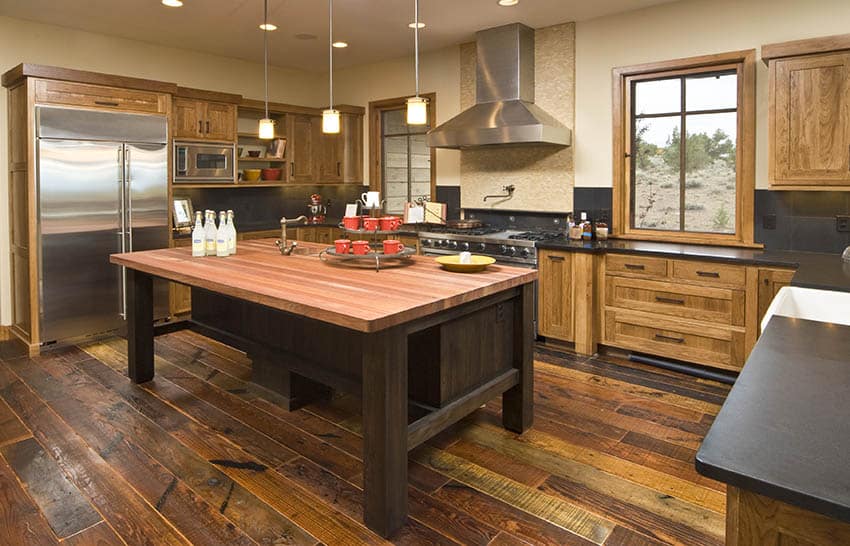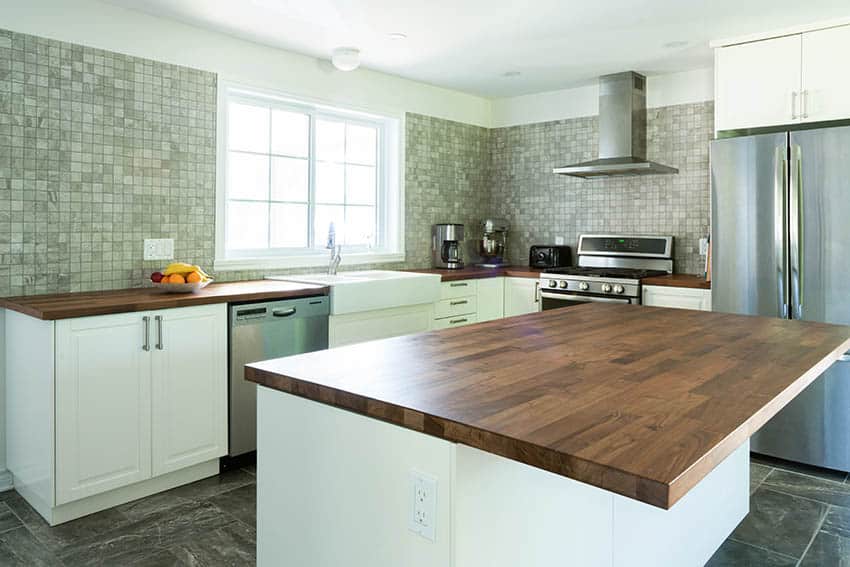Are Butcher Block Countertops Worth It? An Interior Designer’s View

The most important aspect of kitchen and bathroom design is the countertop. More often, it is the homeowner’s sense of style, and their lifestyle is what determines the right countertop for them.
Countertops are an investment, and it is a choice that homeowners would want to last for years to come. In choosing countertops, consider the overall design of the room – what will work seamlessly with cabinets, flooring, and other design elements.
Butcher Block Countertop Styles
Back in the 1880s, butchers worked on using thick rounds of sycamore; but these types were prone to splitting. It was in the early 1900s when butchers started using maple – a hard wood which when straight cuts of this wood were glued together into a thick slab, it provided a sturdy, stable and durable work surface that better stood up to meatcutters’ cleavers.
Today, the butcher block is the only type of countertop surface that allows for direct cutting and slicing. Also known as wood countertops, the butcher block countertop is a warm alternative to cool stone countertops.
The thickness of this counter generally ranges from two to twelve inches and has different grain types.
Edge Grain
For edge grain construction the edges of this board are assembled by placing long boards on their sides and joining them showing their long narrow edges to form a light work surface. The boards are finger-jointed at random length or can be continuous lengths of wood with no joints.
This type of counter is the most commonly used and appears to be less interfering than the squares of a butcher block.
Face Grain
This type of counter is also called plank grain which contains planks kept together with the wide surface vertically positioned. By this orientation, this type of countertop features the beauty of the grain.
End Grain

The ends of these boards are positioned upward forming a unique checkerboard appearance. This is the strongest and most expensive type.
For an eco-friendlier option, these counters can be made out of reclaimed wood from solid wood from old homes and barns.
You can even opt to use domestic wood from managed forests. Bamboo countertops are also a popular alternative option since it is a renewable grass but with a surface that is extremely hard and sturdy. Now we’ll discuss the pros and cons, starting with the advantages.
Pros and Cons
Pros:
Naturally anti-bacterial countertop – Since it is made out of wood, these counters have natural anti-bacterial and anti-microbial properties.
Attractive appearance – They develop a lovely patina over time.
Warm look – These counters adds warmth and natural coloring to the kitchen.
Can be refinished – Wood counters can be refinished and easily restored. Knife scratches, deep gouges and burn marks can be lightly sanded and the surface reoiled with food-safe mineral oil.
Low cost – They can be budget-friendly since it cost less than half the starter price for natural stone or engineered materials.
Durable – These countertops are a long lasting and durable choice especially if maintained properly.
Think green. Most manufacturers offer sustainably grown certified woods and these counters can be recycled.
Can muffle the sound of appliances – They are a soft material that is easy on glassware and dishes which when dropped on this type of counter are less likely to break. Wood also quiets the whir of appliances unlike stone countertops which amplify such noise.
Easy to install – The installation can be easy and finishing wood is straightforward.
Cons:
Not resistant to heat & staining – They are not heat or stain resistant. Liquids such as vinegar can seep into the wood which can actually dissolve the glue and trigger joint separation. Liquids penetrating the wood can also cause stains and cracks.
Need to take care with hot pans – Hot pans need a pad or trivet before setting it down on the counter. These counters are not fireproof either.
Moisture can damage the surface – Excessive wetness and exposure to moisture make the counters susceptible to rot and discoloration.
Can warp or bend under certain conditions – Due to extreme dryness or humidity, they can swell or make the material shrink which may cause cracking. All wood expands and contracts with changes in atmospheric conditions making it prone to cup, warp and create gaps.
High maintenance – Unfinished counters require monthly oiling and refinishing at least every five years.
Are These Countertops Durable?
High level of durability is one of the biggest benefits for your kitchen countertop. With proper care and maintenance, these counters are known to have a lifespan of twenty years.
While most materials would be damaged by blades and knives, these counters can protect both cutlery and its wood surface due to its end grain fibers which has the ability to naturally separate, bend back and mend themselves.
Are Wood Surfaces Sanitary?
According to the studies made, these countertops are safer when it comes to harboring microbes such as E-Coli, listeria, and salmonella due to having natural anti-bacterial and anti-microbial properties.
One study reported that more than 99% of the disease-causing bacteria applied to wood countertop died within three minutes.
It is very important that you keep your counter clean by regularly applying food-safe butcher block oil to your counter surface to help prevent the wood from drying and cracking; do this at least monthly.
Occasionally disinfecting your counter with a mixture of salt and lemon will help kill bacteria and brighten the surface of your countertop.
Are These Countertops Expensive?
Prices of this counter vary depending on the type of wood, grain construction, finish, and thickness.
The average custom-made quality butcher block countertop ranges from $12 to more than $200 per square foot; add 5% to 10% more for most factory finishes.
This is more expensive than the mid-range quality granite, but it does cost less than the top-of-the-line natural stones.
Types of Butcher-Block Countertops & Cost
Here are some ideas of the cost, uninstalled and with a 1 ¼ inch thickness:
- Birch – approximately $12 per square foot
- White Oak – approximately $12 per square foot
- Hard Maple – approximately $40 per square foot
- American Walnut – approximately $60 per square foot
- Bamboo – approximately $90 per square foot
- Brazilian Cherry – approximately $115 per square foot
- Iroko – approximately $115 per square foot
- Saxon Wood – approximately $150 per square foot
- Mesquite – approximately $151 per square foot
- Bolivian Rosewood – approximately $200 per square foot
Best Wood For Butcher-Block Kitchen Countertops
Most butcher block countertops are made from maple, one of the best and most popular types due to its hardness and having a clear grain.
Red oak and cherry offer a rich color, while walnut, teak and nowadays, bamboo is gaining popularity. A more exotic choice of wood used are wenge, zebrawood and iroko.
This type of countertop material is often used for lower-traffic applications or smaller work surface such as kitchen islands wherein it doubles as dining areas.
- Birch –t his is a fine grain wood, neutral and light colored.
- White Oak – showy grains on brown strips.
- Hard Maple – a classic butcher block material, strong wood with straight and uniform grains.
- American Walnut – has rich chocolate colors with prominent black grain and is an excellent accent piece countertop recommended for an island.
- Bamboo – imported grass now becoming a popular material for countertop, heat-treating can give bamboo a caramel hue.
- Brazilian Cherry – this fine-grain exotic wood is tough to scratch or dent.
- Iroko – this is an imported African wood has bright gold boards which mellows in time to a teak-like brown color.
- Saxon Wood – this New South American is yellow-brown color wood with gray and black streaks.
- Mesquite – it is the hardest wood, the mineral streaks in them adds character to its reddish-brown strips.
- Bolivian Rosewood – heavy wood with black stripes on a rich brown background.
Is It A Good Countertop Material?
A well-finished chunky, thick butcher block is a good choice for a countertop because it adds more warmth and pop against cold, single-hued countertop. It has in itself an organic and sophisticated aesthetic.
These counters have such versatility in them, each type of wood has its own unique characteristics that adds beauty to your kitchen. They are a good choice since there is an option to use wood that do not require staining such as the walnut wood.
Staining with different colors and glosses can change the look of any wood that would fit perfectly to the design scheme and practical for different settings.
A common concern is cleaning and maintenance – but actually, it is not much of a problem at all. Having the wood countertop treated or sealed by a professional before use, can be a good investment as it will prolong wear and tear of the countertop.
There are plenty of products available and DIY cleaning stuff which can help keep the surface clean and germ-free.
You can use food safe protective coating such as FDA-approved mineral oil; this gives the counter a matte look and seeps in to make wood resistant to moisture, heat, and stain.
Another option is to use a nonpetroleum based walnut oil or pure tung oil; once applied, this oil hardens to form a film that will not peel and will protect your wood countertop.
Oil-wax blend made from mineral oil and beeswax, or paraffin wax will add another layer of protection against moisture.
It also helps seal the oil into the wood by applying it with a clean cloth, let it sit for 20 minutes then remove excess and buff to a satiny finish.
One more food-safe finish which can provide these counters superior protection against water, stains, and wear are fully cured urethane, acrylic, or resin-curing oil.
What do you think of these butcher block countertops pros and cons? If there is any we’ve missed please let us know in the comments below. For another gallery like this visit our page about live edge wood countertops.













